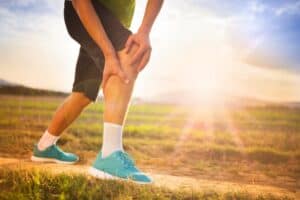Every athlete, whether amateur or professional, knows that with the thrill of the game comes the risk of injury. From casual joggers to dedicated team players, nobody is entirely immune to the occasional sprain or strain. But did you know that some sports injuries are more common than others? By understanding which injuries are most frequent and how they occur, we can take proactive measures to avoid them.
This article delves into the most common sports injuries and offers practical advice on how to keep yourself safe while enjoying your favorite activities.
The Top 4 Most Common Sports Injuries
Even though there are hundreds of different types of sports injuries, certain areas of the body are more likely to be damaged than others. These areas make up nearly eighty percent of all sports injuries. Here are some of the most common sports injuries:

1. Achilles Tendinitis
Pain and inflammation can occur when the Achilles tendon, located at the back of the foot, becomes overused. This is known as Achilles Tendinitis. When left untreated, the condition can worsen until it becomes nearly impossible to run.
This sports injury is most common among athletes who are involved in sports that require running and jumping. Stretching the calf muscles before any high-impact activity can help to prevent this injury. As far as treatment, rest, ice, compression and elevation is your best option. You can also try massage therapy or ultrasound therapy to help with inflammation. Additionally, it’s important that you don’t play sports until the sports injury is completely healed.
2. Concussion
An injury to the brain, known as a concussion, is usually caused by injury to the head. Disorientation, loss of vision, dizziness, amnesia, loss of balance, nausea, and trouble concentrating are the most common symptoms of a concussion. However, an individual doesn’t have to lose consciousness to obtain a concussion.
This sports injury is most common among sports such as football, boxing, hockey, and soccer. Concussions can also occur in sports like skiing and gymnastics. However, most people improve within a few weeks, although multiple concussions can cause permanent damage.
The best way to treat a concussion is to get plenty of rest and take Tylenol if you’re experiencing pain. Additionally, you may have to avoid playing sports for anywhere between a few hours to a few months. Also, if you have experienced an injury and believe you may have a concussion, you should seek professional medical attention immediately.
3. Runner’s Knee
Nearly fifty-five percent of all sports injuries are knee injuries. This injury is most common among runners, cyclists, swimmers and football players. Runner’s Knee can also occur from overuse, which can lead to irritation of the tendon located below the kneecap.
Replacing your shoes regularly and finding a softer surface to run on can help to prevent Runner’s Knee. It can also help to strengthen your quadriceps and rest more between workouts. If an injury does occur, you should avoid exercise for at least two days and take supplements such as Vitamin D for inflammation.
4. Shoulder Injury
Almost twenty percent of sports injuries involve the shoulder, which can include dislocation, sprains, and strains. This type of injury is most common in tennis, swimming, weightlifting, baseball, and volleyball. Injury is usually caused by overuse, which causes the rotator cuff to loosen.
Pain, stiffness, and weakness are common symptoms of a shoulder injury. Shoulder injuries commonly occur when the shoulder muscles are inactive for a while. You can prevent injury by strengthening your shoulder muscles through weightlifting. To treat an injured shoulder, relax, use ice, compression, and elevation, in addition to chiropractic care which can help relieve inflammation.
How To Prevent Sports Injuries

For an athlete, there is nothing worse than being benched midseason. The problem is that many people who participate in sports are so focused on becoming better at the sport they play that they forget that you must work the whole body to enhance performance. When it comes to sports injuries, the weakest link is the one that does the most harm. To prevent sports injuries, try these tips and tricks to remain injury-free!
1. Weight Train
The best way to prevent sports injuries is to build muscle strength, both for the performance of the sport you play and for your core musculature. If you don’t train your core muscles, then you will create an imbalance that could lead to getting hurt and sitting out the next game. Whether you are a swimmer or a runner, working out the entire body through functional weight training is not only the best way to improve your performance, it is the only way to stay strong and injury-free.
- Foam Roller Exercises – Using a foam roller to stretch the muscles is great to ease yourself into your sport again. Start off gentle, using the foam roller will probably hurt but this is normal. If you’re unsure of what to do with the foam roller, then look at this article written by Women’s Health about 7 awesome ways to use a foam roller.
- Stretching Exercises – When trying to heal sports injuries, doing stretching exercises will help unless your doctor specifies otherwise. There are many different types of stretching exercises for all the areas of the body. To stretch the shoulders, try doing some arm circles stretches. To target the lower back, try the cat stretch or child’s pose. The cat stretch and child’s pose are commonly used in yoga. For the neck, use the chin to chest stretch. And for the abdominals, you can do the scissor kick stretch.
- Plyometric Exercises – Plyometrics or plyometric exercises are a form of strengthening exercise, incorporating jumping, bounding and hopping movements, which works to increase power in the muscles. Power is used in the vast majority of all sports, so plyometrics can be used to help develop this for most athletes. There are many plyometric exercises you can try. Some are the plyo push-up, squat thrusters, reverse lunge with knee-ups, long jumps, and frog jump squats. All of these exercises will help build your strength up again and heal sports injuries.
- R.I.C.E Method – This stands for Rest, Ice, Compression, and Elevation. Take time to rest and relax even for several minute intervals in your day. Any rest is better than none. Apply an ice pack for 10 to 15 minutes as soon as possible after an injury. Repeat the ice treatment each hour for the first four hours, then four times a day for the next two to three days. Protect your skin with a thin cloth, and don’t allow your skin to become red, blistered, or numb. For compression, pressure will help reduce swelling and inflammation. In most cases, a simple elastic bandage will suffice; it should be snug but not too tight. And for elevation, keep your sore foot or limb up on a hassock or put a pillow under it in bed.
2. Massage Therapy
People who play any type of sport will deal with a sports injury at some point. These injuries often occur from repetitive stress on your muscles or bones. Using massage therapy for your sports injury can help to counteract the pain. The pressure you will feel from the massage will increase blood flow, which warms the muscles. Massage therapy will also help to reduce any swelling in joints or muscles. It can even help the pain to subside so your injury heals faster. The most common form of massage therapy people use to help sports injuries is a Swedish massage. This type of massage allows your therapist to do a variety of techniques such as kneading or tapping. The four most common strokes in Swedish massage are below:
- Effleurage – This a smoother stroke that helps to relax soft tissues.
- Petrissage – This stroke is traditionally used after effleurage. It is the kneading sensation that you feel in a Swedish massage.
- Friction – These are the deeper circular strokes that are mainly used to increase blood flow. This stroke is particularly helpful to those with sports-related injuries.
- Tapotement – This stroke is more of a tapping sensation using cupped hands or fingers.
3. Warm Up
Your muscles are kind of like rubber bands. Have you ever pulled on a cold rubber band? When you don’t warm up and just get right to it, your muscles might not be prepared for the activity, and you have a greater likelihood that you can sprain or pull a muscle. All it takes is about five minutes to warm up before you engage in exercise to prevent an injury.
4. Stretch
It is important to stretch both before you begin playing sports and after. When muscles are short, they are weak. And a weak muscle is more prone to injury. When you keep your muscles long and flexible, they are less likely to succumb to injury when you are out on the playing field.
5. Listen to Your Body
Your body is equipped with pain sensation to alert you when things aren’t right. If you ignore those pain cues, you are increasing your risk of a sports injury. It is okay to push yourself to do more and to be better – but not at the expense of hurting yourself. If you try to go too fast, then you might be slowed down really quickly by a sports injury. Listen to what your body is telling you and take some time when it needs to heal and repair.
6. Don’t Overtrain
Too much of a good thing is still too much. If you are overtraining and going overboard without giving your muscles time to recover and heal, you are going to end up with a sports injury. The way that a muscle builds is through the recovery process. If you don’t allow your muscles the time necessary to repair and rebuild, you are making them vulnerable to a sports injury.
It’s a good idea to have a workout based on your specific individual needs. We also offer genetic testing that tells us your genetic makeup, so we can help you train more efficiently and specifically based on your own specific genes. The testing gives you information on what percentage of your work out should be endurance training and what should be power training. As a result, you can reap the benefits based on your specific genetic code.
Conclusion

No one steps onto the field or hits the gym thinking they’ll get hurt, but the reality is that injuries are an inherent part of physical activities. By being informed about the most common sports injuries and their prevention, we arm ourselves with the best defense: knowledge. It’s essential to listen to your body, get proper training, wear the right gear, and always prioritize safety. Remember, it’s not just about playing hard; it’s about playing smart. Here’s to many more games, matches, runs, and workouts – injury-free.
To learn more about sports injuries, injury prevention, and how a chiropractor can help, contact us today!
